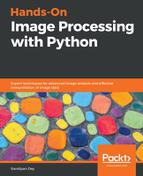The Difference of Gaussian (DoG) kernel can be used as a BPF to allow the frequencies in a certain band and discard all other frequencies. The following code block shows how the DoG kernel can be used with fftconvolve() to implement a BPF:
from skimage import img_as_float
im = img_as_float(pylab.imread('../images/tigers.jpeg'))
pylab.figure(), pylab.imshow(im), pylab.axis('off'), pylab.show()
x = np.linspace(-10, 10, 15)
kernel_1d = np.exp(-0.005*x**2)
kernel_1d /= np.trapz(kernel_1d) # normalize the sum to 1
gauss_kernel1 = kernel_1d[:, np.newaxis] * kernel_1d[np.newaxis, :]
kernel_1d = np.exp(-5*x**2)
kernel_1d /= np.trapz(kernel_1d) # normalize the sum to 1
gauss_kernel2 = kernel_1d[:, np.newaxis] * kernel_1d[np.newaxis, :]
DoGKernel = gauss_kernel1[:, :, np.newaxis] - gauss_kernel2[:, :, np.newaxis]
im = signal.fftconvolve(im, DoGKernel, mode='same')
pylab.figure(), pylab.imshow(np.clip(im, 0, 1)), print(np.max(im)),
pylab.show()
The following screenshot shows the output of the preceding code block, the output image obtained with the BPF:

